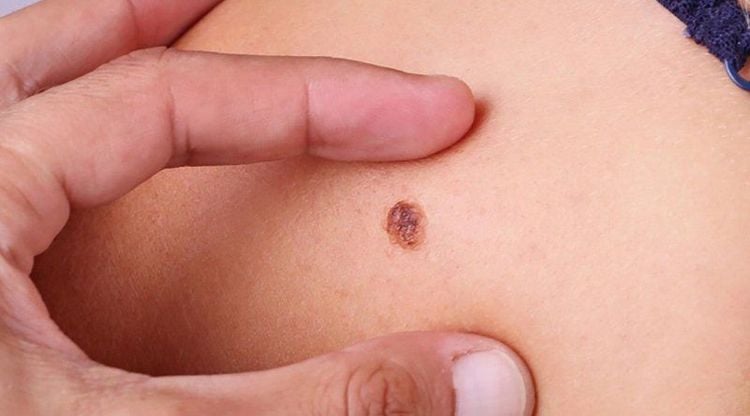This is an automatically translated article.
Skin cancer is detected when there are changes in the skin, such as the appearance of tumors, patches or moles of various shapes and sizes. The most common cause of skin cancer is exposure to ultraviolet rays from the sun.
1. Sites of skin cancer
Skin cancer locations on the body can be found in places that are exposed or not exposed to much sunlight such as: under the nails, on the head, eyelids,...
Under the nails: Under Fingernails or toenails can be one of the sites of skin cancer. The tumor is most commonly found on the thumb and big toe, but it can be under any nail. Tumors are not usually caused by sun exposure, but can be a past trauma. If you notice a dark streak under your fingernails or toenails for no apparent reason, see a dermatologist for help promptly. Sole of the foot: If you find on the sole of the foot a dark patch, which can also be red or orange, different from the surrounding area, it is usually melanoma. Asians and African Americans have a higher incidence of this type of cancer than any other type of melanoma. You will likely have surgery to remove the cancer and continue treatment with radiation, chemotherapy, or biological immunotherapy. Palms: If you have dark skin, melanoma is more likely to occur in areas of the body that are not exposed to the sun as much as the palms of the hands and soles of the feet. The incidence of melanoma is higher in darker-skinned people. Melanoma is often more serious than other malignancies, in part because people often don't find it until the disease is more advanced and difficult to treat.

Ung thư da có thể xuất hiện dưới móng tay
Eyelids: The eyelid is also a common site of skin cancer because it is often exposed to sunlight. If detected and treated early, it is usually not serious, you can surgically remove it. Cancer begins most often in the basal cells in the upper layer of the skin (epidermis). A more serious form of cancer starts in the squamous cells, even closer to the surface of your skin. This type grows faster and spreads easily to nearby tissues. Scalp: The scalp often has lumps or red nodules, but these are not usually cancerous. In fact, only about 13% of all skin cancers are on the scalp, often less severe, non-malignant cancers such as basal cell carcinoma and squamous cell carcinoma. If it is cancerous, it may be a small, smooth, waxy lump that may bleed or scab over. Get medical attention right away if you have pain in your head. Inside the ear: If skin cancer outside the ear (squamous cell or basal cell) is not found and treated, it may spread to the inside of your ear. It affects the ear canal that runs from the outer ear to the small bones in your middle ear and to the nerves. Tongue: If you notice white, hard, flat patches on your tongue (leukoplakia) that can't be scraped off, or tingling, loss of sensation, a lump or sore that won't go away, it's usually squamous cell . The cause of these symptoms is usually smoking or heavy drinking, or both. The doctor may take some cells from the suspected area for a biopsy. You will usually have surgery to remove it. Lips: Basal cell or squamous cell cancers are types of skin cancer that most commonly affect your lips. Your lower lip is about 12 times more likely to darken than your upper lip, which doesn't get as much sun. Men also get cancer in this location more often than women, possibly because men tend to use tobacco and alcohol more. Your risk of skin cancer is also increased if you have the papillomavirus (HPV), which can cause warts on your genitals, hands, or other places. Iris: The iris may appear "uveal" or "intraocular" melanoma. It looks like a black spot in the iris colored around the pupil. You may also have blurred or blurred vision. Skin cells called melanocytes grow out of control and form a tumor. This is the most common form of skin cancer that starts in the eye, and it can spread to other parts of the body through the lymph nodes and through the bloodstream. White of the eye: Conjunctival melanoma is a cancerous growth that grows on the conjunctiva, the transparent membrane that covers the surface of the eye and the inner eyelid. It usually appears as a black or red spot in the white of your eye. It can be serious and can spread to other parts of the body through the lymph nodes or the bloodstream. If your doctor suspects it, they may take a tissue sample to look at under a microscope.

Các loại ung thư da cần được phát hiện sớm
2. Skin cancer prevention Talk to your doctor if your family has a history of various types of skin cancer. Some factors that can increase the risk of sun damage leading to cancer include:
Light skin; Freckles or moles that are large, numerous, or oddly shaped, asymmetrical; a lot of time outside, especially at higher altitudes or very hot places; Illness or medication that weakens your immune system; Taking certain medications makes your skin more sensitive to light. Skin cancer, if detected early, can often be cured. Therefore, it is important that you regularly check your skin for any abnormalities. Standing in front of a mirror and holding a hand-held mirror can help you see hard-to-see places. Watch for new growths or changes in old spots, as they can be signs of dangerous problems such as cancer. See a dermatologist once a year or whenever you notice something unusual.
Above is information about skin cancer locations and how to prevent them. If you see any abnormal signs on your skin, go to a medical facility for timely examination and support.
Please dial HOTLINE for more information or register for an appointment HERE. Download MyVinmec app to make appointments faster and to manage your bookings easily.
Reference source: webmd.com












